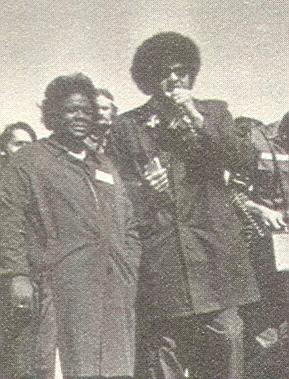Johnnie Tillmon facts for kids
Quick facts for kids
Johnnie Tillmon
|
|
|---|---|

Johnnie Tillmon is on the left, and George Wiley (a founder and executive director of the National Welfare Rights Organization) is on the right.
|
|
| Born |
Johnnie Lee Percy
April 10, 1926 |
| Died | November 22, 1995 (aged 69) |
| Nationality | American |
| Other names | Johnnie Tillmon |
| Organization | Aid to Needy Children Mothers Anonymous National Welfare Rights Organization |
| Known for | Welfare rights activist |
| Movement | Civil rights movement Welfare rights Women's rights |
| Children | 6 |
Johnnie Tillmon Blackston (born Johnnie Lee Percy; April 10, 1926 – November 22, 1995) was an American activist. She worked to make sure people receiving welfare (government help) were treated fairly. Many people see her as one of the most important welfare rights activists in the United States. Her work with the NWRO even influenced the Civil Rights Movement and leaders like Dr. Martin Luther King, Jr..
Contents
Early Life
Johnnie Tillmon was born on April 10, 1926. Her family were sharecroppers, meaning they farmed land owned by someone else. When she was five, her mother passed away. In 1944, she went to live with her aunt. Johnnie did not finish high school.
She married James Tillmon in 1948, but they divorced in 1952. In 1959, she moved to California to be with her brothers. By then, she was a single mother raising six children.
Fighting for Rights
Helping Families in Need
In California, Johnnie found a job in a laundry. She became a union shop steward, helping workers with their rights. In 1963, she became ill and missed work. She worried about her children not having enough care because of her job. So, she left her job and began to receive welfare.
After getting public assistance, Johnnie saw how welfare officials sometimes treated people. They would do "midnight raids" to check on families. This made her upset. She decided to organize other mothers and welfare recipients in her neighborhood. She lived in the Nickerson Garden housing project.
Within a few months, Johnnie and her friends started a group. It was called Aid to Needy Children-Mothers Anonymous. This was one of the first groups made by welfare mothers themselves. Later, this group became part of the National Welfare Rights Organization (NWRO). George Wiley, a civil rights activist, became the NWRO's first leader. Johnnie Tillmon was the first chairman. At its busiest, in the late 1960s, the NWRO had almost 25,000 members.
In 1972, George Wiley left his role. Johnnie Tillmon moved to Washington, D.C., to become the NWRO's executive director. This was a paying job, which meant she no longer needed welfare. She led the organization until 1974, when it closed due to money problems. After that, she went back to California. There, she worked to help make new laws and served on welfare committees.
Women's Rights
The NWRO was mostly made up of women. These women were some of the few female leaders in the civil rights movement. They were also among the first to say that poverty often affected women more. Johnnie Tillmon wanted to connect the welfare rights movement with the women's rights movement. She tried to get support from groups like the National Organization for Women (NOW).
Johnnie often spoke to women's groups. She explained that poverty was a "women's issue." She compared the rules of welfare to an unfair marriage. The main women's liberation movement at the time was mostly younger, middle-class white women. They focused on women's right to work outside the home. But the women of the welfare rights movement were mostly Black women. They also had organizers in Puerto Rican and Native American communities. They focused on motherhood and making welfare a guaranteed right. At that time, welfare programs could change or stop benefits if a mother had more children or if a male partner moved in.
In 1972, Johnnie Tillmon wrote an important essay. It was called "Welfare Is a Woman's Issue." It was published in Ms. magazine. In her essay, she said that women had a right to enough money. This was true whether they worked in a factory or stayed home raising children.
Later Life and Legacy
In 1979, Johnnie Tillmon married her second husband, Harvey Blackston. He was a blues harmonica player known as Harmonica Fats. They lived in Watts, California, near Nickerson Gardens.
Johnnie Tillmon passed away on November 22, 1995, in Los Angeles. She was 69 years old. Her death was caused by diabetes. Before she died, she had used a wheelchair and needed dialysis for four years.
In 1996, Harmonica Fats released an album called Blow, Fat Daddy, Blow!. It was dedicated to Johnnie Tillmon's memory.
The National Union of the Homeless later used a way of organizing that they called the "Johnnie Tillmon model." This showed how important her ideas were for helping people.

